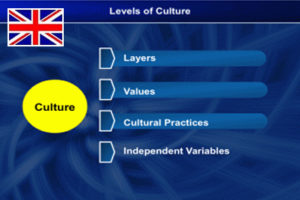
 Levels Of National Cultures
Levels Of National CulturesThe first complexity in understanding culture is related to the different levels of depth of cultures. With the “onion assumption”, Hofstede (1980, 2001) explains that values drive practices (behaviors) in a positive way, i.e., when people value something, they act alike. The general consensus is that people behave based on their values and beliefs of how things should be done (e.g., Hofstede 1980; Schwartz 1999; Hofstede 2001; Schein 2004). This manifests in symbols, heroes and rituals.All three are visible to the outside world as practices of a certain culture; “their cultural meanings, however, are invisible” (Hofstede 2001: 10), referring to the core values at the heart of the culture. However, the notion that values and beliefs drive behavior has recently been questioned by House et al. (2004). They showed the opposite (Javidan et al. 2006b: 902): “People may hold views of what should be (i.e., values) based on what they observe in action (i.e., practices)”. One explanation is that people generally desire more of something they do not have. Another explanation could be found in the questionnaire design aimed at measuring “contextualized values”. House et al. conclude that the “onion assumption” of Hofstede is too simplistic and additional research is needed to explain such a complex relationship (Javidan et al.2006b: 901). For this study, cultural practices are considered to be more robust indicators or explanatory factors of actual behavioral differences compared to cultural values. For example, Smith et al. state that “the ‘as is’ ratings comprise the most extensive survey to date that has focused on the description of behaviors” (2006: 49). In conclusion, taking the GLOBE study as the primary cultural study of choice, this study focuses on the cultural practices as independent variables explaining differences in the professional behavior of auditors. The cultural values will function as a set of “second-tier” independent variables of reflecting culture where relevant.
About Professor C.J.M. Beniers
Prof. C.J.M. Beniers is a well known authority in the field of modern and international communication techniques. He developed the Six-Component-Model. This model enables companies, institutions and politicians to communicate and negotiate with counterparts from all over the world successfully. His career began as international manager at Philips and later he earned his doctorate as professor in communication. He has more than 35 years experience as manager and management trainer. Thus he knows both sides – theory and praxis – very well. As scientist, Prof. Beniers conducts frequently research in the field of intercultural communication. The results of his interesting research can be found in news articles, free pod casts, audio books and his E-books such as “Bridging The Cultural Gap.” Here, modern managers learn how to prepare for business meetings with people from different cultures; they acquire the techniques and tools to handle situations in times of crises successfully, master intercultural barriers, country-specific communication patterns, looking into personal cultural values & systems. Knowing all this, men can prevent cultural misunderstandings and misinterpretations – not only in business but also in private life.
14-01-2015
Email: info@beniers-consultancy.com
Website: https://www.beniers-consultancy.com